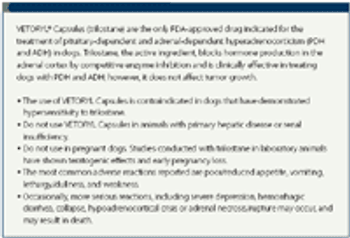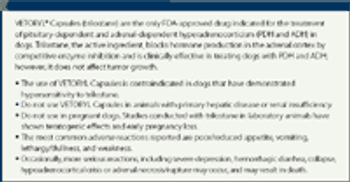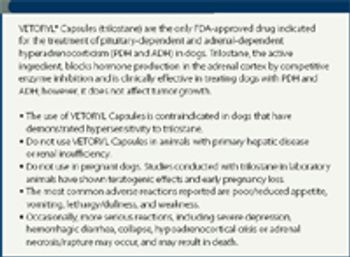
Bonding hormone improves cue-taking ability in dogs, researchers assert.

Bonding hormone improves cue-taking ability in dogs, researchers assert.

Investigating the best way to monitor dogs with hyperadrenocorticism and whether fructosamine concentrations can be used to monitor glycemic control in diabetic patients.

Knowing the barriers to care may aid in educating clients and addressing concerns that may impede care.

Diabetes mellitus is a common endocrine disorder in dogs and cats.

Pituitary-dependent hyperadrenocorticism

Insulin resistance is a condition in which a normal amount of insulin produces a suboptimal biologic response.

Hyperthyroidism is recognized as the most common endocrinopathy of older cats. Despite worldwide occurrence, the pathogenesis of feline hyperthyroidism remains unclear.

Cushing's syndrome refers to all causes of hyperadrenocorticism with overproduction of cortisol.

Canine hypothyroidism, while a common endocrinopathy in the dog, may be over diagnosed due to confusion/inconsistencies in establishing a definitive diagnosis.

Diabetes mellitus is a common endocrine disorder in dogs and cats.

How to make in-house blood glucose curves in cats comfortable for all.


A look at which factors might make spontaneous normalization of glycemic control more likely in one of your feline patients.

If not, Dr. J. Catharine Scott-Moncriefl explains why you should be.

This information about survival times and prognostic factors can provide valuable information for clinicians to better educate owners about treatment expectations and outcomes.

A study looks at the diagnosis and treatment of hypoadrenocorticism in cats.

Dr. David Bruyette comments on the latest developments in treating canine PDH and whether or not pituitary surgery will take the place of medical therapy.

It can be intimidating in a complex case such as Boca's to try a new drug and treatment protocol for the first time.

This case illustrates the need to evaluate the patient history and results of routine blood tests to help identify hyperadrenocorticism as a possible differential diagnosis.

The use of properly dosed VETORYL Capsules is strongly recommended rather than compounded trilostane to ensure maximal efficacy and safety during medical management of hyperadrenocorticism.

Drs. Wakayama and Bruyette offer a look at treatment options and considerations for feline acromegaly.

Drs. Wakayama and Bruyette offer a look at which diagnostic tests are most beneficial in detecting this often underdiagnosed condition.

See what veterinary endocrinologist Dr. David Bruyette recommends as the go-to insulin to treat diabetes mellitus in dogs.

An underestimated financial benefit exists for any practice that produces satisfied clients who have pets with well-controlled diseases that live longer lives.

Mitch was presented to his primary care veterinarian for evaluation of polyuria and polydipsia of six months' duration.